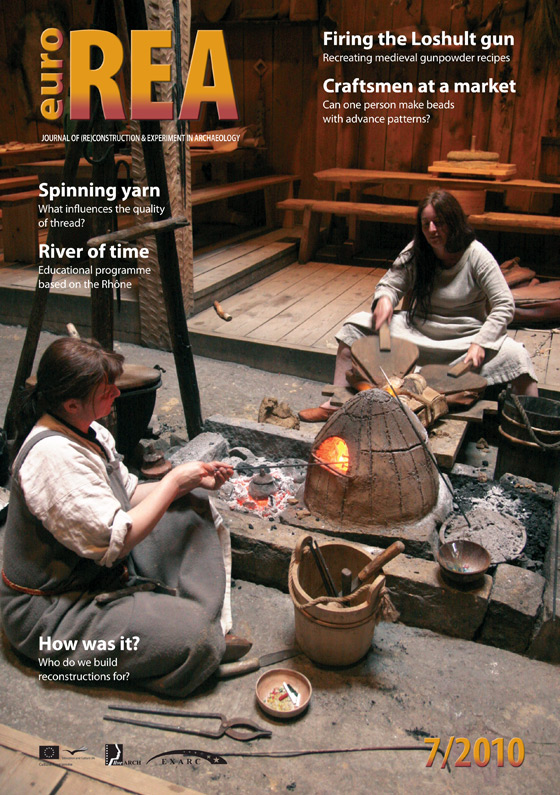
© EXARC, 2010
ISBN 13: 978-90-78657-05-7
Size: A4, 72 pages
Archaeological open-air museums allow us to present archaeological findings to the wider public in their cultural context. Their credibility is tied firmly to experimental research. However, both experimental archaeology and archaeological open-air museums often depend on individuals. These come with a good idea, get support and remain the driving force. We see the vulnerabilities of this: people like experiments, they enjoy visits to archaeological open-air museums but when there are financial cuts, it is clear that for many experiments and museums are not a necessity. In 2009, the Peat Moors Centre near Bristol closed its doors. Trelleborg in Denmark will probably continue without much of its live interpretation far from being a live museum. Finally, as another example, Lejre has decided to keep its scientific department mostly ‘off line’ for a season to save money. At the same time, new archaeological open-air museums are opening to bring tourists to regions. It is exciting to start something new, less to keep it going. To maintain the quality of archaeological reconstructions it is necessary not to loose the sight of either the museums aims or loose experience. Here EXARC plays a vital role. It has always been a good arena to exchange experience. Hopefully, the contacts made through EXARC and mutual support will lead to a more sustainable future for both archaeological open air museums and experimental archaeology.
In the seventh issue (all articles are available as PDF):
Feuersteinpapst in Rente - Harm Paulsen wird 65 (PDF)
REPORTS - Söhnke Hartz, Wulf Hein (DE)
Experimental ironmaking once more: combining theory and find material (PDF)
DISCUSSION - Arne Espelund (NO)
Experimental Archaeology: Methodology and new perspectives in Archaeological Open Air Museums (PDF)
DISCUSSION - Lara Comis (IT)
Archaeological OpenAir Museums: a possible new way forward (PDF)
DISCUSSION - Jacqui Wood (UK)
Experiment and Knowledge Base: bringing historical textile workers together (PDF)
ITEMS - Katrin Kania (DE)
Making Glass Beads from the past (PDF)
ITEMS - Jannika Grimbe (SE)
Early guns and gunpowder - experiments and ethnoarchaeological research (PDF)
ITEMS - Peter Vemming (DK)
Creating products for tourism - the example of Lofotr Viking Museum (PDF)
ITEMS - Leonie Peter (DE)
There is live after ARCH (PDF)
REPORTS - Roeland Paardekooper (NL)
Conference world (PDF)
REPORTS - Martin Bell, Anna Petrauskiene and Andrey Petrauskas, Jodi Reeves Flores, Natalie Uomini, Katrin Kania, Hans-Ole Hansen, Kathrin Schäppi und Stefanie Osimitz, Arne Espelund
The Museum of Ledro: an Incubator for Cultural, Economical and Ecological Development (PDF)
REPORTS - M. Cristina Vannini, Romana Scandolari (IT)
From archaeological evidence to experimental reconstruction and back (PDF)
REPORTS - Roberto Deriu, Claudia Fredella (IT)
Swords, bread and games: The largest Roman living history event of 2009, but then different (PDF)
REPORTS - Roeland Paardekooper (NL)
Stanislas Bonfils (1823-1909) at the dawn of experimental archaeology (PDF)
REPORTS - Bertrand Roussel, Elena Rossoni (FR)
Learning through experience (PDF)
EDUCATION - Ane Riis Svendsen (DK)
"On Board into History" (Embarquez dans l'Histoire) (PDF)
EDUCATION - Camille Daval (FR)
Brushwood's Big Dig (PDF)
EDUCATION - Philippa Holden (UK)
Questionnaire: Presenting archaeological reconstructions to the public (PDF)
DISCUSSION - Raimund Karl, Oto Makýš, Hannah Simons, Cornelius Holtorf , Wolfgang F. A. Lobisser, Charis Zachariou, Bodil Petersson
Reviews (PDF)
Experiencing Archaeology by Experiment
Guide to the Archaeological Open Air Museums in Europe
World Archaeology vol. 40
Langage de Pierre
Management and presentation of oppida – a European overview
A Review for A Mudbrick City Wall at Hattuša
Kuhinjska kultura v zgodnjem srednjem veku